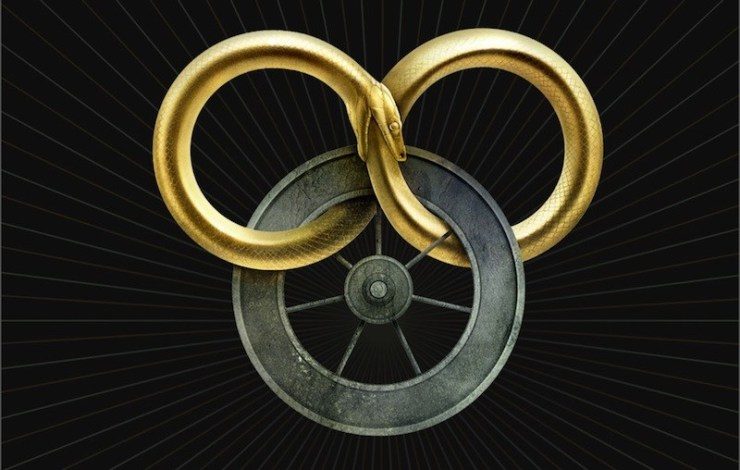I made a great number of discoveries while researching and writing Origins of the Wheel of Time. None of them changed my life quite like this one: the map was wrong.
Not the map of the Westlands that appeared in each of the main books in one way or another—sometimes in black and white, sometimes in glorious full color. That map, drawn by Ellisa Mitchell, remains as true to Jordan’s vision today as it was when The Eye of the World was published in 1990.
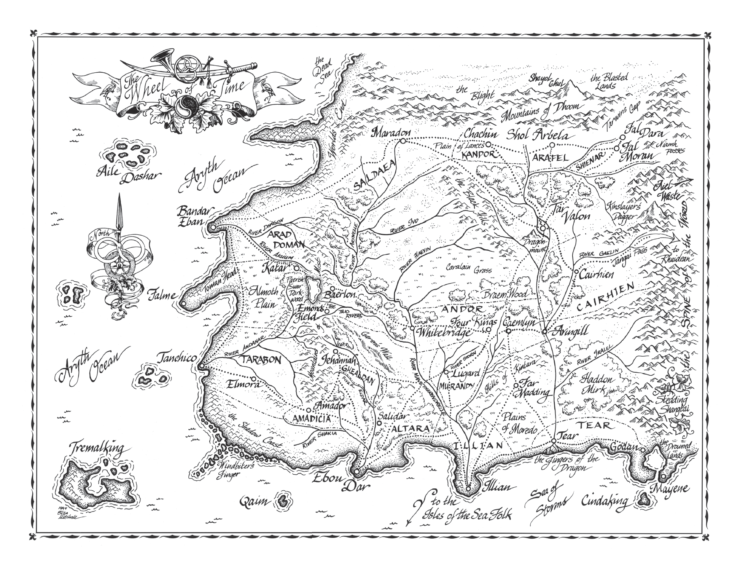
No, I mean the other map. The one of the entire world that was printed in The World of Robert Jordan’s Wheel of Time, a companion book to the series that was published in 1997—a book that fans call, somewhat affectionately, the Big White Book.
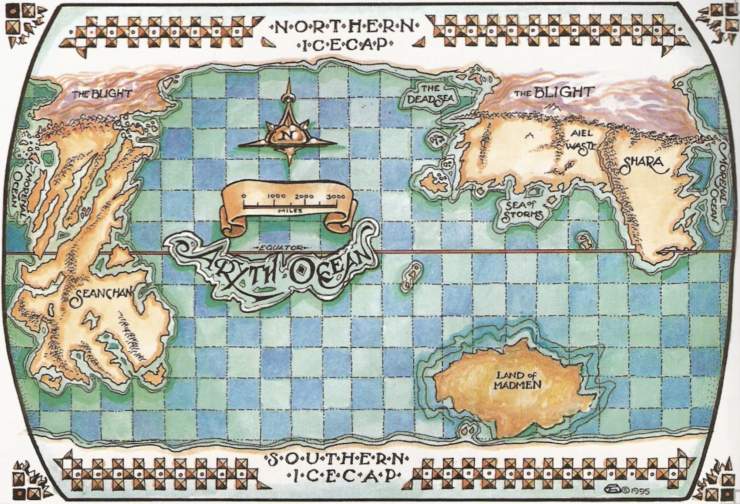
This map presents the larger picture of the Randland world: not just the Westlands where the main action takes place, but the surrounding continents and oceans, with the Aiel Waste, Shara, the Land of Madmen, Seanchan, and more Blights than you can shake a withered stick at.
There’s not a lot of detail on it, but I was still fascinated by this little map when it first appeared. I loved it not just because I loved the Wheel of Time and was desperate for any new information about the world that Jordan was building, but also because I simply loved maps.
It’s true. I’m a map aficionado. Among my earliest memories is spending hours combing through a huge, hardbound Atlas of the World, memorizing names and land features. Other early memories featured folded topo maps and compasses as I hiked the Rockies with my father, who worked for the US Geological Survey. Then, later, came Tolkien’s map of Middle-earth, which brought together a passion for cartography and a fascination with imaginary landscapes. Even in writing my own fiction, I always made the map first, knowing that action is defined by the ground on which it happens—a lesson I carried over to my current work finding and reconstructing ancient and medieval battles.
So a whole map of Jordan’s world? Gimme, gimme, gimme.
Fast-forward to late 2021, with me in a pandemic mask, poring through the boxes and boxes of materials in the archive of the Rigney Papers at the College of Charleston, researching my once-in-a-lifetime book on Jordan and his work. It was amazing.
Anyway, among the items in the archive are a series of folders from the writing of the Big White Book: drafts, edits, and correspondence between Jordan and the publisher. Like everything else, I went through the papers dutifully.
Much of it is the kind of thing you’d expect. Change this word. Be sure this illustration goes on this page. That sort of stuff.
But then I found pages showing drawings of the world map—the map exactly as it was printed, the map exactly as I knew it—and Jordan writing that it was wrong.
Wrong twice over.
First, there was the continent in the southern seas of Randland, one known for violent and unpredictable male channelers who’d turned the land itself into a chaotic, tortured sight. I’d already started writing about the origins of this place for my book, and I’d done so referring to it as the “Land of the Madmen,” because that’s what it was called in the Big White Book map. But here, going over that very same drawing, Jordan objected to the title. He did the same several times, in fact. One note to the publisher was remarkably succinct: “Land of Madmen is wrong. Should be The Mad Lands,” he wrote (Rigney Papers, Box 51, Folder 9).
So, yeah, there’s no “Land of the Madmen.” It’s “The Mad Lands.” Huh.
Second, there was the enormous continent of the Seanchan across the Aryth Ocean west of the Westlands. Here, the author’s concerns were literally larger. Commenting on the same world map—again, the map that I’d taken as canon from the Maker himself—Jordan wrote that the size and shape of the continent was incorrect: “extend Seanchan a little farther south. Make southern portion of Seanchan wider by 75%, all south of equator.”
This wasn’t just a label problem. This would be a truly world-altering change. So I assumed that Jordan must have changed his mind about it later in the publication process for the Big White Book. Surely they couldn’t have gone to print with a map so incorrect, right?
Well, I couldn’t find any indication that Jordan ever changed his mind. Instead, I found repeated pleas for the alterations, including a letter, written on November 25, 1996, stating firmly that the map “needs correction” (Box 32, Folder 2). Less than a year later, however, the erroneous map was in print.
About a month before I was working through these various notes in the archive, I had raised the idea of making a new world map for Origins, one that might show a bit more detail than the one in the Big White Book. Now, I went back to Harriet and the Estate with a further ask: if we made a new map, should it match the published one or Jordan’s notes?
I was strongly of a mind that we owed it to Jordan to get it right, but I knew this wasn’t a small ask. Not only would a corrected map make the Big White Book in error, but it would also affect The Wheel of Time Companion, published in 2015, which had been overseen by Harriet and Team Jordan. That book referred to “The Land of the Madmen” throughout. So I was asking to reshape canon.
The Estate said to do it. Even more astonishingly, Tor immediately got Ellisa Mitchell herself contracted to draw it, so that our new and more accurate map of Randland would match her much-loved map of the Westlands in style. It was an amazing sequence of emails to get, I assure you.
Almost immediately, though, my mind turned to a whole series of big questions.
Putting a new label on a continent was easy, but how exactly did we reshape one? Jordan said to “extend Seanchan a little farther south. Make southern portion of Seanchan wider by 75%, all south of equator.” Ok, but what should that look like? How far was “a little farther”? Should Seanchan grow wider to the east, the west, or both? What did this do to the shape of the coastlines?
For that matter, if we were making these kind of changes, should we make a few more, too? Jordan’s early notes described a major barrier reef on the eastern shoreline of Seanchan—one through which there was only a single navigable passage. I couldn’t find anywhere that this reef had fallen out of his plans, but I also couldn’t find confirmation that it had stayed in. So did we add that?
What about Ishamael’s Fortress? Given the materials that Jordan was working with, I had a very strong sense of where it should be, but I had no smoking gun to say for sure. Should we add it?
And what about fixing some of the errors in the Seanchan topography that Jordan hadn’t noted? For instance, some of the river routes sketched into the map in the Big White Book defied the laws of nature (and, I’d argue, of physics, too).
For that matter, what about adding more detail of roads and rivers in Seanchan? Or in Shara? I had whispers of where some of these things might be located, but I hardly had all of them.
I outlined all of these questions and more in a letter to Harriet, the Estate, and the folks at Tor, written on the last day of 2021. With the caveat that my vote didn’t really count, I offered up my suggestions and my rationale for them. I didn’t think we should add in roads in Seanchan, for instance, “as we’d be adding whole cloth at that point,” I wrote, “but if Harriet wants it done I will absolutely do whatever I can to help make it happen.”
The next day, the calendar turned to 2022.
Not a week later, I was told it was up to me.
I know I must have kept breathing when I read it, but I don’t recall doing so … and I don’t really know how I could’ve managed it. It was remarkable enough that I was writing Origins, after all. As I’ve said, I couldn’t call the book a dream come true because I never would have dared to dream of it. And now—Light help me—I was tasked with reshaping the world of the Wheel of Time.
Not figuratively. Literally.
And so I sat—at Jordan’s desk, surrounded by Jordan’s notes—and sketched out the changes that I thought should be made. As with everything else in Origins, my sole determination was to get it how Jordan would have wanted it. I did it with an open heart, a full mind, and an enormous spread of books and papers, but I also did it with an aim to err on the conservative side of the possibilities.
Buy the Book
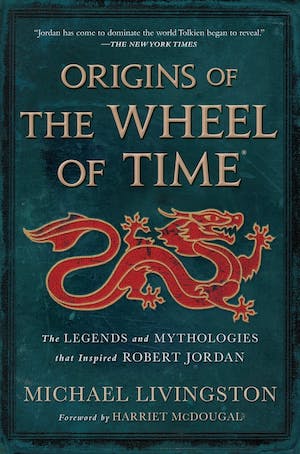

Origins of the The Wheel of Time
A lot of Origins worked this way, in fact. There are things we have from something Jordan clearly said or wrote. As long as he didn’t later contradict these tidbits, they’re 99% likely to be true. (I’d say 100%, but statisticians would surely object!) A step down from this are things that I’m maybe 90% sure of: we don’t have that smoking gun from the author, but they pretty much have to be true. And so it goes, with lesser and lesser odds until we get to those things that I think are there but I can’t back up with much more than a hunch and a feeling.
When it came to writing Origins, I packed my contracted word count with the information that I could support to a very high degree. In so doing, I left as much of myself behind in order to favor the surety of Jordan’s vision.
So when it came to the map, I didn’t add any of the roads in Seanchan or elsewhere. I didn’t include Ishamael’s Fortress (I’d call my odds on that around 75%). I didn’t add the barrier reef, either. As I wrote at the time:
The barrier reef was part of the original materials, yes, but [Jordan’s] more mature notes on Seanchan run to several hundred pages—and I can’t find them referenced anywhere in there. This, plus the fact that he didn’t make note of adding them when he asked for the changes to the continent map, makes me inclined to think he’d changed his mind on why more ships didn’t make the crossing.
As for what the continent should look like, I first tackled the question of which way the southern portion should be made wider. Looking at the map he was commenting upon, going wider to the west would have taken the continent clean off the map. I felt reasonably confident that Jordan would have mentioned the need to expand the map in that direction if that’s what he was wanting. Since he didn’t, the widening of Seanchan would need to occur within the map, and that meant going east. Doing so, I noted, would also have the effect of making the continent’s coastlines “fit” better with those of the Westlands and the Waste—a suitable mimic of plate tectonic results in our own world, like the way that South America and Africa can stitch together.
Additionally, going east made sense to me because it would help resolve something that had previously been a bit of a mystery to readers: why did the Seanchan cross the wide expanse of the Aryth Ocean to get to the Westlands when the distance to reach them was seemingly less across the Morenal Ocean? At least part of the answer was that Seanchan was much closer than the published map had shown.
What about the coastline shapes and everything else? Well, Jordan had objected to the proportions of southern Seanchan, but he hadn’t said things were otherwise wrong. The most reasonable move, then, was to “stretch” the existing map eastward below the equator. I sketched this out and it was sent along to Ellisa.
I made a few other changes. I felt confident that those rivers that ran against nature on the Big White Book map were “artistic flourishes rather than [Jordan]-approved topography,” as I wrote at one point. Sure, I didn’t have anything directly from him saying they were wrong, but given everything I knew of the man, I felt certain he wouldn’t let them stand. He’d simply not said anything about it at the time because he was trying to get the far bigger problems fixed first.
It would have been nice to make major alterations to the Seanchan landscape. It was such a mess to my eye that the temptation was real. In the end, though, I again opted for making the smallest changes to the precedents that would nevertheless resolve the problems with them. I was, as I said at the time, “trying to thread the needle between respecting them and making them make sense.”
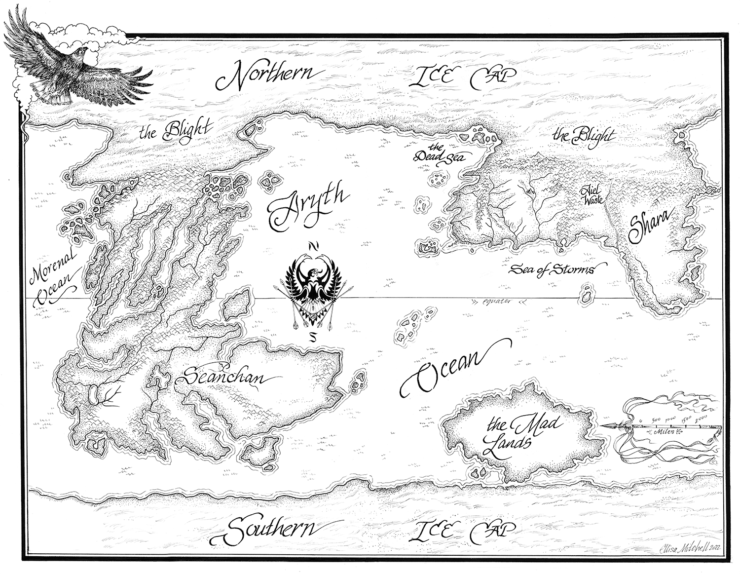
Keen eyes comparing the two maps will see—through the lens of Ellisa’s amazing artwork—how I made modifications in the least intrusive way I could. If I was starting from scratch with Jordan’s personal approval, I’d absolutely remake the topography in more significant ways, but no matter how often I was told things were up to me, I simply didn’t want to go that far. All of this, of course, was going through checks by the Estate, though I can’t think of an instance where they didn’t give a thumbs-up. The message at one point from Jordan’s assistant, Maria, was “Anything that Mike suggests is good by me”—which blew me away.
I’m sure a lot of folks are reading this and imagining how exciting it would be to have such a hand in re-making Randland. From the outside, I might well say the same thing.
But the truth is that there’s a lot of weight in being made a Maker in a made world that you respect and love. I think inevitably one feels a sense of impostor syndrome.
This is something I talked about with Brandon Sanderson at one point, trying to get a handle on how he managed it. I won’t speak for him, but I’ll say that for my part I made peace with the fact that at every turn I had done the best I could, that Harriet and Maria—and seemingly everyone else who was ever involved in the Wheel of Time—had checked my work, and that I’m certain that Jordan’s desk would’ve up and crushed me if I’d gotten it wrong.
That is, after all, how magic tends to work.
–Michael Livingston
The Citadel










